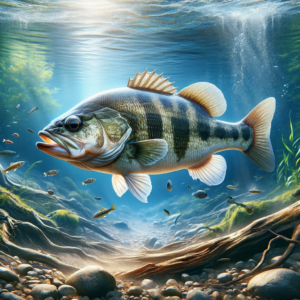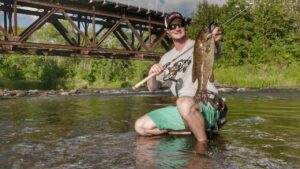Have you ever wondered if smallmouth bass still bite in the rain? It’s a common question among anglers, as rainy weather can often deter people from heading out to fish. But you might be surprised to learn that not only do smallmouth bass bite in the rain, but they can actually be more active and easier to catch during these conditions. In this article, we’ll dive into the details of fishing for smallmouth bass in the rain, including the best techniques and strategies to increase your chances of success. So if you’re ready to become a rain-ready angler, keep on reading!
When it comes to fishing for smallmouth bass in the rain, there are a few key things to keep in mind. First and foremost, rain can create a lot of surface disturbance, which can make it harder for smallmouth bass to spot your bait. This means that you’ll need to adjust your presentation accordingly. Try using baits with more vibration and noise, such as spinnerbaits or crankbaits, to grab their attention. Additionally, the rain can also cause the water temperature to drop, which can trigger the feeding instincts of smallmouth bass. So even though the conditions may not be ideal for you, they can actually work in your favor when it comes to attracting these fish.
One important tip to remember when fishing for smallmouth bass in the rain is to focus on structure and cover. Smallmouth bass are known to seek shelter during inclement weather, so look for areas with rocks, fallen trees, or vegetation where they can hide. These structures provide a sense of security for the fish and offer them a place to ambush their prey. By targeting these areas, you’ll increase your chances of hooking into a smallmouth bass.
In conclusion, don’t let rainy weather keep you from enjoying a successful day of fishing for smallmouth bass. Not only do these fish bite in the rain, but they can actually be more active and easier to catch during these conditions. Just remember to adjust your presentation, focus on structure and cover, and be prepared for a potentially fruitful day on the water. So next time it’s raining outside, grab your gear and head out to your favorite fishing spot – the smallmouth bass might just be waiting for you!
Preparing for Rainy Fishing
When it comes to fishing for smallmouth bass, many anglers wonder if they bite in the rain. The answer is yes, smallmouth bass can be active and caught in rainy conditions. However, there are a few factors to consider and some adjustments to make in order to increase your chances of success. In this article, we will discuss various techniques, adjustments, and strategies for catching smallmouth bass in the rain.
Check the Weather Forecast
Before heading out for a day of fishing in the rain, it’s essential to check the weather forecast. While smallmouth bass can be caught in the rain, it’s important to know the severity of the rain and any potential thunderstorms. Thunderstorms can be dangerous, so it’s best to avoid fishing during these conditions for your own safety. Additionally, heavy rain may cause the rivers and streams to rise, making fishing more challenging. By checking the weather forecast, you can plan your fishing trip accordingly and choose the best time to fish for smallmouth bass.
Gather the Right Gear
Fishing in the rain requires some additional gear and preparations. Firstly, make sure you have a waterproof jacket or rain gear to keep you dry throughout the day. Staying dry will not only keep you comfortable but also help you stay focused on catching fish. Additionally, it’s important to protect your gear from the rain. Invest in waterproof tackle boxes or bags to keep your lures, hooks, and other fishing equipment dry. Wet gear can be a hassle and may even affect your chances of catching fish. By gathering the right gear and preparing adequately, you can ensure a successful and enjoyable fishing trip in the rain.
Techniques for Catching Smallmouth Bass in the Rain
Targeting Sheltered Areas
When it’s raining, smallmouth bass tend to seek shelter in calmer waters. Look for areas with natural cover such as fallen trees, rocks, and banks that provide protection from the rain. These sheltered areas serve as hiding spots for smallmouth bass, making them more likely to bite. Pay close attention to these spots and target them with your lures or bait.
Using Vibrating Lures
Vibrating lures are highly effective for smallmouth bass fishing in the rain. The vibration and noise generated by these lures mimic the movements of prey, attracting the attention of bass. Opt for lures such as crankbaits or spinnerbaits that produce a significant amount of vibration. The added noise and disturbance in the water can trigger the bass’s predatory instincts, enticing them to strike.
Working Surface Lures
In rainy conditions, smallmouth bass tend to feed closer to the water’s surface. Utilizing surface lures, such as topwater poppers or frogs, can be highly effective. These lures create a commotion on the water’s surface, imitating injured prey and drawing the attention of bass. By working these lures slowly and methodically, you can increase your chances of enticing a strike from a hungry smallmouth bass.
Focusing on Currents
Rainy conditions often lead to an increase in water flow and currents. Smallmouth bass are naturally drawn to these areas, as the increased flow brings a potential food source. Focus your efforts on fishing in and around currents, such as eddies or areas where the water is churning. Use lures or bait that can be presented effectively in these conditions, such as jigs or soft plastics. By targeting areas with strong currents, you can increase your chances of catching smallmouth bass in the rain.
Adjustments to Your Fishing Approach
Slightly Slower Retrieve Speed
In rainy conditions, smallmouth bass can become slightly sluggish and less active. To entice a bite, it’s important to adjust your retrieve speed. Slow down your retrieval technique, allowing your lure or bait to stay in the strike zone for a longer period of time. By mimicking the slower movements of injured prey, you can increase your chances of attracting a bite from a smallmouth bass.
Bait Color Selection
Choosing the right bait color is essential when fishing for smallmouth bass in the rain. The cloudy and dim lighting conditions can make it difficult for bass to spot lures or bait. Opt for brighter colors such as chartreuse, orange, or white, which are more visible in low-light situations. The contrast created by these colors can make your lure or bait more noticeable and tempting for smallmouth bass.
Utilizing Natural Bait
In rainy conditions, smallmouth bass may also be more inclined to feed on natural bait. Live bait such as nightcrawlers, minnows, or crayfish can be highly effective in attracting bites. Use a slip-sinker rig or Carolina rig to present the live bait naturally in the water. By using natural bait, you can tap into the bass’s instinctual feeding behavior and increase your chances of success in rainy conditions.
Reading the Rainy Conditions
Identifying Rainfall Patterns
Reading the rainfall patterns can give you valuable insight into where the smallmouth bass may be located. If it has been raining continuously for a while, the fresh rainfall will wash nutrients and food sources into the water, attracting smallmouth bass. Look for areas where rainwater is flowing into the main body of water, such as tributaries or runoff points. These areas act as natural feeding grounds for bass, making them more likely to be present.
Observing Water Clarity
One important factor to consider when fishing in the rain is water clarity. Rain can have a significant impact on water clarity, making it murky or muddy. Smallmouth bass tend to rely on their eyesight to locate prey, so when the water becomes murky in the rain, they may struggle to find their next meal. In these conditions, it’s best to use lures or bait that create more sound or vibrations. By choosing lures that make a lot of noise or emit strong vibrations, you can increase your chances of attracting fish even in low visibility.
Monitoring Water Temperature
Rainfall can also have an effect on water temperature. Heavy rain can cool down the water, while a light drizzle may not have a significant impact. Smallmouth bass may adjust their behavior and feeding patterns based on the water temperature. In cooler water, they may be more active and willing to bite, whereas in warmer water, they may be less active. Monitor the water temperature and adjust your fishing techniques accordingly to maximize your chances of catching smallmouth bass in the rain.
Understanding Smallmouth Bass Behavior in Rain
Active Feeding Behavior
Rainy conditions can trigger smallmouth bass to go into feeding mode. The rain washes insects and other food sources into the water, providing a feast for the bass. This active feeding behavior can work to your advantage as an angler. By presenting your bait or lures effectively, you can capitalize on the bass’s increased appetite and catch more fish.
Shoal Movement Patterns
Smallmouth bass tend to gather in groups or shoals, especially during the spawning season. In rainy conditions, these shoals may move to different areas in search of food or shelter. It’s important to understand the movement patterns of smallmouth bass in rainy conditions to maximize your chances of success. Look for areas where bass typically congregate, such as drop-offs, rocks, or reefs, and target these spots with your lures or bait.
Impact on Spawning
Rainy conditions can have a significant impact on the spawning habits of smallmouth bass. During the spawning season, which typically occurs in the spring, smallmouth bass create nests or beds on the lake or river bottom. The rain can cause changes in water level and temperature, affecting the stability and location of these nests. Understanding the impact of rain on the spawning behavior of smallmouth bass can help you adjust your fishing approach accordingly.
Tips for Tackling Inclement Weather
Dressing Appropriately
When fishing in the rain, it’s important to dress appropriately to ensure your comfort and safety. Wear waterproof clothing, including a jacket, pants, and boots. Opt for materials that are breathable to prevent excessive sweat buildup. Additionally, consider wearing a hat or cap to keep the rain off your face and a pair of polarized sunglasses to improve visibility in low-light conditions. By dressing appropriately, you can focus more on catching fish and enjoy your fishing trip in the rain.
Enhancing Tackle Protection
Rain can damage your fishing gear, including your rods, reels, and lures. To protect your equipment from the rain, it’s important to take some precautions. Use rod covers or carry your rods in waterproof cases to prevent water damage. Similarly, opt for reels with sealed bearings to keep water out. Consider using waterproof tackle boxes or bags to store your lures and hooks, keeping them dry and in good condition. These simple measures can prolong the life of your fishing gear and ensure that it performs optimally in rainy conditions.
Safety First
While fishing in the rain can be an exciting experience, it’s crucial to prioritize your safety. When thunderstorms are present, it’s best to avoid fishing altogether. Thunderstorms can be extremely dangerous, with the risk of lightning strikes. If you are already on the water and a thunderstorm approaches, it’s important to seek shelter immediately. Move to a safe location, such as a sheltered cove, and wait for the storm to pass before continuing your fishing trip. Always keep an eye on the weather conditions and prioritize your safety above all else.
Effective Rain Fishing Strategies
Switching to Slow-Sinking Bait
In rainy conditions, smallmouth bass can become less active and reluctant to chase fast-moving lures. Switching to slow-sinking bait can be an effective strategy to entice a bite. Slow-sinking lures, such as soft plastics or jigs, mimic the movements of injured or dying prey, which is an easy target for bass. Cast your bait, let it sink to the desired depth, and use a slow and subtle retrieve to entice the bass into striking.
Varying Retrieval Techniques
Experimenting with different retrieval techniques can be beneficial when fishing for smallmouth bass in the rain. As the bass may be less active, it’s important to vary your retrieval speed, pauses, and jerks to make your lure or bait more enticing. Try using a combination of slow and fast retrieves, incorporate pauses to mimic injured prey, and add occasional jerks to create attention-grabbing movements. By varying your retrieval techniques, you can trigger the predatory instincts of smallmouth bass and increase your chances of success.
Scent Enhancement
The rain can wash away scent trails, which may make it more difficult for smallmouth bass to locate your bait or lures. Adding scent enhancement to your bait can be a game-changer. There are various commercially available fish attractants and scents specifically designed for bass fishing. These scents can create a trail in the water, making your bait more enticing and effectively attracting smallmouth bass. Consider incorporating scent enhancement into your fishing strategy to improve your chances of catching fish in the rain.
Utilizing Local Knowledge and Experience
Seeking Advice from Local Anglers
If you are fishing in a new location or unsure about the best spots to target smallmouth bass in the rain, seeking advice from local anglers can be invaluable. Local anglers have firsthand knowledge of the area, including the specific spots where smallmouth bass are likely to gather in rainy conditions. They can provide valuable insights, tips, and recommendations that can significantly enhance your fishing experience. Strike up a conversation with fellow anglers or join fishing forums to connect with local experts and gather information about fishing in your area of interest.
Experimenting with Different Approaches
Catching smallmouth bass in the rain requires adaptability and flexibility. While certain techniques and strategies may work well in general, it’s important to experiment with different approaches to find what works best in specific rainy conditions. Don’t be afraid to try different lures, retrieve speeds, bait presentations, or fishing locations. By being open to experimentation and willing to adapt, you can enhance your chances of catching more smallmouth bass in the rain.
Importance of Patience and Persistence
Persevering in Adverse Conditions
Fishing in the rain can be challenging. It requires patience and perseverance to overcome the discomfort and adversity that come with inclement weather. Smallmouth bass can be fickle, and bites may be fewer and farther between in rainy conditions. However, it’s crucial to remain focused and persistent. Continue casting, varying your techniques, and exploring different areas until you find the fish. Remember, even a single bite can make all the difference, so stay motivated and keep fishing.
Taking Breaks when Necessary
While persistence is important, it’s also essential to listen to your body and take breaks when necessary. Fishing in the rain for an extended period can be physically and mentally draining. If you find yourself becoming fatigued or losing focus, take a short break to rest, recharge, and refocus. Use this time to evaluate your fishing strategy, adjust your gear, or simply enjoy the surroundings. Taking breaks when necessary can improve your overall fishing experience and help you maintain your enthusiasm and energy throughout the day.
Conclusion
Catching smallmouth bass in the rain can be both challenging and rewarding. By following the techniques, adjustments, and strategies discussed in this article, you can increase your chances of success. Remember to check the weather forecast, gather the right gear, and adjust your fishing approach accordingly. Understand the behavior of smallmouth bass in rainy conditions, read the water, and utilize effective fishing strategies. Seek advice from local anglers and be patient and persistent in your pursuit. With the right knowledge and preparation, you can make the most out of your rainy fishing trips and enjoy an exciting and fruitful day on the water.




